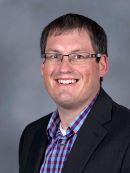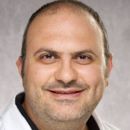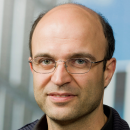The Research Development Office recently granted six $47,000 awards as a part of the OVPR Interdisciplinary Scholars program, part of the Seeding Excellence Initiative.
Over an 18-month period, the funding will support a range of radiochemistry projects that ultimately seek to improve human health, including developing new methods to assess radon exposure, improving radiation therapy, and understanding the mechanisms underlying serious airway disease.
The Research Development Office offered seed funding as a follow-up to a campus symposium, “Unlocking the Power of Radiochemistry: From Medical Imaging to Nuclear Energy.” Hosted in February 2024, the symposium aimed to raise awareness of the breadth of radiochemistry research happening on campus and connect researchers to spur innovative interdisciplinary research. The winners will present their findings and determine a path for securing external funding at a second symposium in 2026.
“Our goal is to enable teams of researchers to build on new or existing strengths to achieve significant growth in interdisciplinary radiochemistry research and applications,” said Aaron Kline, director of the Research Development Office. “Ultimately, we hope that this work will lead to the successful submission of proposals for external funding.”
Investigators from five colleges are engaged in the collaborative projects, including the Carver College of Medicine, the State Hygienic Lab, and the colleges of Engineering, Liberal Arts and Sciences, Pharmacy, and Public Health.
Awards
Integrative Radiochemistry and Environmental Health: A Novel Non-Invasive Toenail Biomarker for Personalized Radon-Induced Lung Cancer Risk Assessment

In the United States, lung cancer screening programs primarily rely on smoking history and age as eligibility criteria. However, these criteria overlook other significant risk factors, including radon (222Rn), a naturally occurring radioactive gas prevalent in Iowa that is the second leading cause of lung cancer after smoking. This research team will explore a novel, non-invasive method for assessing lifetime radon exposure by analyzing toenail samples for lead-210 (210Pb), a “radon progeny,” a radioactive element that occurs as radon decays.
Project team: Jong Sung Kim, associate professor of occupational and environmental health, College of Public Health; Muhammad Furqan, clinical associate professor of internal medicine, CCOM; Dustin May, environmental laboratory manger, State Hygienic Laboratory; Hans-Joachim Lehmler, professor of occupational and environmental health, College of Public Health; Kai Wang, professor of biostatistics, College of Public Health
A geochemical study of uranium and radium sources to Iowa groundwaters: potential impacts from agricultural nitrogen contamination and increased demand

The interdisciplinary research team will examine the Cretaceous-Dakota aquifer and alluvial aquifers in western Iowa as potential sources of radium and uranium, which impact human health. Utilizing the University of Iowa’s MatFab Facility, the investigators will develop and validate new methods for analyzing radium, uranium, and thorium radioisotopes. The team will also explore the co-occurrence of specific geological or environmental factors that lead to concentrations of these substances.
Project team: Drew Latta, assistant research scientist, IIHR—Hydroscience and Engineering, College of Engineering; David Peate, professor of earth and environmental sciences, CLAS; Dustin May, environmental laboratory manger, State Hygienic Laboratory; Keith Schilling, director, Iowa Geological Survey, College of Engineering; Richard Langel, research specialist, IIHR—Hydroscience and Engineering, College of Engineering.
Characterization of SSTR2 targeted α-particle bystander damage for the purpose of maximizing therapeutic antioxidant combinations in small cell lung cancer

A new class of radiopharmaceuticals harnesses the power of alpha-particles to deliver large amounts of radioactive energy specifically to small cell lung cancer tumors, damaging DNA and reliably killing the targeted tumor cells. Unfortunately, the receptor target on the surface of small cell lung cancer lacks uniform expression across tumors. The targeted cell and neighboring “bystander” cells suffer detrimental effects. For this project, the research team will characterize these injurious effects to bystanders, which will assist in the design of better therapeutic combinations.
Project team: Melissa Fath, associate research scientist, Free Radical and Radiation Biology Program, CCOM; Stephen Graves, assistant professor of radiology, CCOM; Michael Schultz, associate professor emeritus, Nuclear Medicine Division, CCOM
Evaluating the effects of magnetite radiolytic decomposition on tumor control

This research team leads a Phase I clinical trial to test the efficacy and safety of ferumoxytol (FMX), an ultrasmall nanoparticle, to treat aggressive brain tumors. With additional funding from the Interdisciplinary Scholars initiative, they will further explore the radiochemical decomposition of FMX, including the effects of conventional radiation therapy. Completion of this project will help provide preliminary data for competitive proposals for extramural funding.
Project team: Michael Petronek, research assistant professor of radiation oncology, CCOM; Tori Forbes, professor of chemistry, CLAS
Selective Radiolabeling of Gel-Forming Mucins in the Airways

The research team will explore mucociliary transport, or the lungs’ natural cleaning system. By secreting mucus, the lungs trap unwanted substances like bacteria, particles, and pollutants, and sweep them out of the airway. Although this process is understood to play a role in airway diseases, there is not a proper technique for measuring its function and control. The research team will develop a tool for understanding the mechanism of mucociliary transport and the role of its various components. Ultimately, they hope to glean insights about the development of various airway diseases, including cystic fibrosis, chronic obstructive pulmonary disease, asthma, and idiopathic pulmonary fibrosis.
Project team: Mahmoud Abou Alaiwa, associate professor of internal medicine, CCOM; David Dick, clinical professor of radiology, CCOM; Thaddeus Wadas, associate professor of radiology, CCOM; John Sunderland, professor of radiology, CCOM
Susceptibility of radioimmunoconjugates to aggregation and the subsequent impacts on their functionality

This highly interdisciplinary team, comprised of a material/pharmaceutical scientist, a veterinarian with immunology expertise, a radiochemist with expertise in PET imaging, and a medical physicist with expertise in dosimetry, will employ a range of experimental approaches to address a knowledge gap that would be extremely difficult to investigate without collaboration among disciplines. Their research project seeks to improve the reliability of radioimmunoconjugates (RIC), radioactive substances that carry radiation directly to cancer cells. The goal is to examine how specific factors during handling, formulation, and injection may create an unwanted immune response that ultimately diminishes the impact of treatment.
Project team: Reza Nejadnik, associate professor of pharmaceutical sciences and experimental therapeutics, College of Pharmacy; Thaddeus Wadas, associate professor of radiology, CCOM; John Sunderland, professor of radiology, CCOM